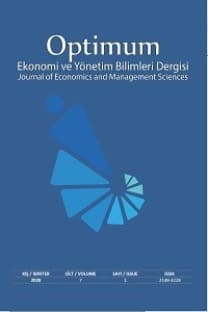Determining the Precedence Order of the Factors Influencing Nurses’ Stress Level Using Multi Criteria Decision Making Techniques
Stres Faktörleri, Hemşire, Analitik Hiyerarşi Prosesi, Çok Kriterli Karar Verme.
Determining the Precedence Order of the Factors Influencing Nurses’ Stress Level Using Multi Criteria Decision Making Techniques
___
- AbuAlRub, R. F. (2004). Job stress, job performance, and social support among hospital nurses. Journal of Nursing Scholarship, 36 (1), 73-78.
- Budak, G. ve Budak, G. (2004). İşletme yönetimi. İzmir: Hayat Yayıncılık.
- Cheng, E. W. L. & Li, H. (2006). Job performance evaluation for construction companies: An analytic network process approach. Journal of Construction Engineering and Management, August, 827-835.
- Dewe, P. (1993). Coping and the intensity of nursing stressors. Journal of Community & Applied Social Psychology, 3, 299-311.
- Ebrinç, S., Açıkel, C., Başoğlu, C., Çetin, M. ve Çeliköz, B. (2002). Yanık merkezi hemşirelerinde anksiyete, depresyon, iş doyumu, tükenme ve stresle başa çıkma: Karşılaştırmalı bir çalışma. Anadolu Psikiyatri Dergisi, 3, 162168
- Foxall, M. J., Zimmerman, L., Standley, R. & Captain, B. B. (1990). A comparison of frequency and sources of nursing job stress perceived by intensive care, hospice and medical-surgical nurses. Journal of Advanced Nursing, 15, 577-5
- Gelsema, T. I., Van Der Doef, M., Maes, S., Janssen M., Akerboom S. & Verhoeven C. (2006). A longitudinal study of job stress in the nursing profession: causes and consequences. Journal of Nursing Management, 14, 289–299.
- Garrosa E., Moreno-Jime´nez, B., Liang, Y. & Gonza´lez J. L. (2008). The relationship between socio-demographic variables, job stressors, burnout, and hardy personality in nurses: An exploratory study. International Journal of Nursing Studies, 45, 418–427.
- Gray-Toft P. & Anderson J. G. (1981). The nursing stress scale; development of an instrument. Journal of Behavioral Assessment, 3, 11-23.
- Ishizaka, A. & Nemery, P. (2013). Multi-criteria decision analysis: Methods and software. New Delhi: John Wiley & Sons, Ltd.
- Lee, S., Kim, W., Kim Y. M. & Oh, K. J. (2012). Using AHP to determine intangible priority factors for technology transfer adoption. Expert Systems with Applications, 39, 6388-6395.
- Lee, M., Holzemer, W. L. & Faucett J. (2007). Psychometric evaluation of the nursing stress scale (NSS) among Chinese nurses in Taiwan. Journal of Nursing Measurement, 15 (2).
- Leveck, M. & Jones, C. (1996). The nursing practice environment, staff retention, and quality of care. Research in Nursing and Health, 19, 331-343.
- Liberatore, M. J. & Nydick, R. L. (1997). Group decision making in higher education using the analytic hierarchy process. Research In Higher Education, 38 (5), 593-614.
- McVicar, A. (2003). Workplace stress in nursing: A literature review. Journal of Advanced Nursing, 44 (6), 633–642. Motowido, S. J., Packard, S. J. & Manning M. R. (1986). Occupational stress its causes and consequences for job performance. Journal of Applied Psychology, 7 (4), 618-629.
- Payne, N. (2000). Occupational stressors and coping as determinants of burnout in female hospice nurses. Journal of Advanced Nursing, 33 (3), 396-405.
- Saaty, T. L. (1990). How to make decision: The analytic hierarchy process. European Journal of Operational Research, 48, 9-26.
- Saaty, T. L. (2008). Decision making with the analytic hierarchy process. Int. J. Services Sciences, 1 (1), 83-98.
- Saaty, T. L. & Sağır, M. (2005). The encyclicon: A dictionary of decisions with dependence and feedback based on the analytic neywork process. Pittsburgh: RWS Publications.
- Saaty, T. L. & Vargas, L. G. (2001). Models, methods, concepts & Applications of the analytic hierarchy process. International Series in Operations Research & Management Science, Kluwer Academic Publishers.
- Stordeur S., D’Hoore W. & Vandenberghe C. (2001). Leadership, organisational stress and emotional exhaustion among hospital nursing staff”. Journal of Advanced Nursing, 35, 533–542.
- Şahin A. (1999). Sağlık çalışanlarının psikolojik sağlığı ve etkileyen faktörler. Sağlık Çalışanlarının Sağlığı 1. Ulusal Kongresi, 80.
- Thirumalaivasan, D., Karmegan, M. (2001). Aquifer vulnerability assesment using analitic hierarchy process and GIS for upper palar watershed. 22nd Asian Conference on Remote Sensing, Singapore, 1-6.
- Tzeng, G. H. & Huang, J. J. (2011). Multi attribute decision making: Methods and applications. CRC Press.
- Yoo, K. E. & Choi, Y. C. (2006). Analytic hierarchy process approach for identifying relative importance of factors to improve passenger security checks at airports. Journal of Air Transport Management, 12, 135–142.
- Yayın Aralığı: 2
- Başlangıç: 2014
- Yayıncı: -
A Review on Hotel Employees within the Context of General & Organizational Cynicism
Fulya Misirdali YANGİL, Metin BAŞ, Seval AYGÜN
Güler ÖNDER, Meryem AYBAS, Emrah ÖNDER
Alparslan Şahin GÖRMÜŞ, Vasfi KAHYA
Kapak, Kurullar ve Bibliyografik Bilgi
A Review on Hotel Employees within the Context of General & Organizational Cynicism
Fulya Misirdali YANGİL, Metin BAŞ, Seval AYGÜN
The Evaluation of Impacts on Business Performance of the Knowledge Leadership
Remark on the Causes of Traffic Accidents and Traffic Awareness: Examples of Usak Province
Ercan ÖZEN, Erhan GENÇ, Zübeyde KAYA
Non-performing Loans in Turkish Banking Sector and Macro Economic Effects
